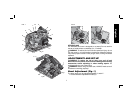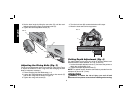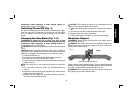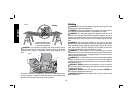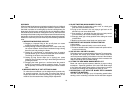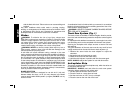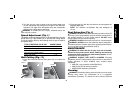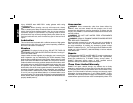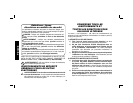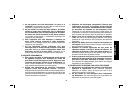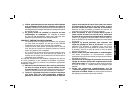
English
14
with the blade in the kerf. Failure to do so can cause stalling and
kickback.
Any other conditions which could result in pinching, binding,
twisting, or misalignment of the blade could cause kickback. Refer
to Adjustments And Set-Up and Operation for procedures and
techniques that will minimize the occurrence of kickback.
Blades
WARNING: To minimize the risk of eye injury, always wear
ANSI Z87.1 approved eye protection. Carbide is a hard but brittle
material. Foreign objects in the work piece such as wire or nails
can cause tips to crack or break. Only operate saw when proper
saw blade guard is in place. Mount blade securely in proper
rotation before using, and always use a clean, sharp blade.
WARNING: NEVER cut ferrous metals (those with any iron or
steel content), masonry, glass or tile with this saw. Damage to the
saw and personal injury may result.
A dull blade will cause inefficient cutting, overload on the saw
motor, excessive splintering and increase the possibility of kickback.
Change blades when it is no longer easy to push the saw through
the cut, when the motor is straining, or when excessive heat is built
up in the blade. It is a good practice to keep extra blades on hand
so that sharp blades are available for immediate use. Dull blades
can be sharpened in most areas; see SAWS-SHARPENING in the
yellow pages. Hardened gum on the blade can be removed with
kerosene, turpentine, or oven cleaner. Anti-stick coated blades can
be used in applications where excessive build-up is encountered,
such as pressure treated and green lumber.
BLADE SELECTION
Your DEWALT track saw is designed for use with 6-1/2" (165 mm)
diameter blades that have a 0.79" (20 mm) diameter bore. Blades
must be rated for 6000 RPM operation (or higher).
DO NOT use any
abrasive wheels.
A combination blade is furnished with your saw and is an excellent
blade for all general ripping and crosscutting operations. Use a fine-
tooth blade for cutting plywood.
WARNING: VISUALLY EXAMINE CARBIDE BLADES BEFORE
USE. REPLACE IF DAMAGED.
Track Saw System (Fig. 1)
The tracks, which are available in different lengths, allow for precise,
clean cuts and simultaneously protect the workpiece surface against
damage.
In conjunction with additional accessories, exact angled cuts, miter
cuts and fitting work can be completed with the track saw system.
Securing the workpiece with clamps ensures a secure hold and
safe working.
The guide clearance of the track saw must be very small for best
cutting results and can be set with the two track adjusters (J).
1. Release the screw inside the track adjuster to adjust the
clearance.
2. Adjust the knob until saw locks on track.
3. Rotate knob back until saw slides easily.
4. Hold the track adjuster in position and lock the screw again.
NOTE: ALWAYS readjust the system for use with other tracks.
Anti-splinter Strip
The track is equipped with an anti-splinter strip, which has to be cut
to size before the first use:
IMPORTANT: ALWAYS read and follow the track saw system
instruction before cutting the anti-splinter strip!
1. Set the speed of the track saw to level 5.
2. Place the track on a scrap piece of wood.
3. Set the track saw on 3/16" (5 mm) cut depth.
4. Place the saw on the rear end of the track.




